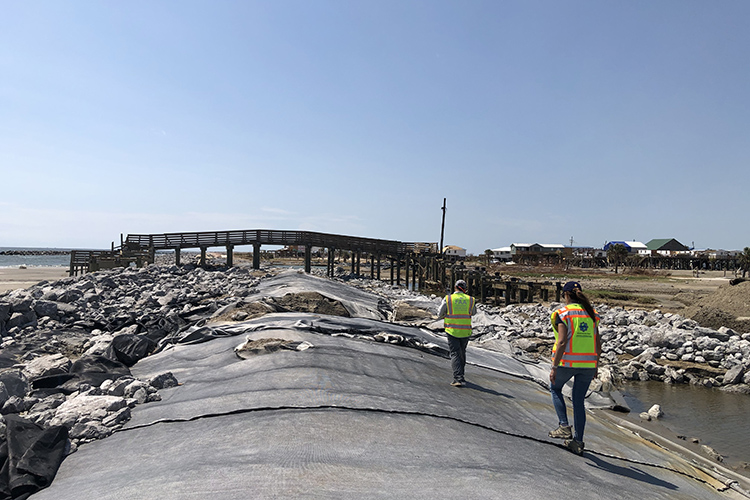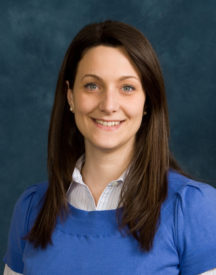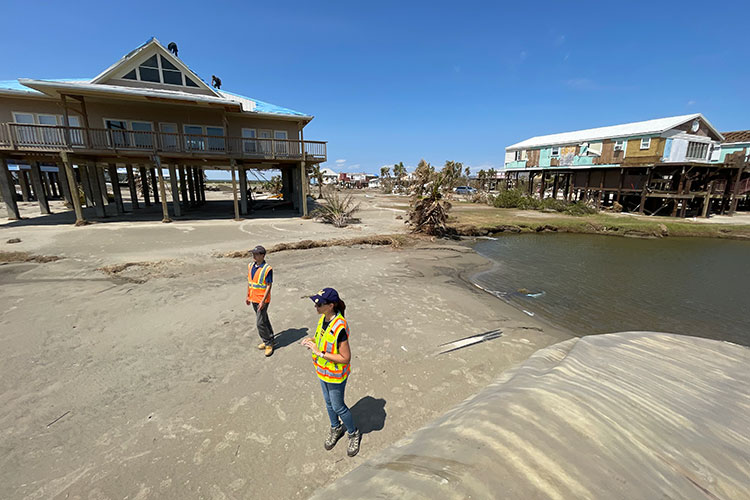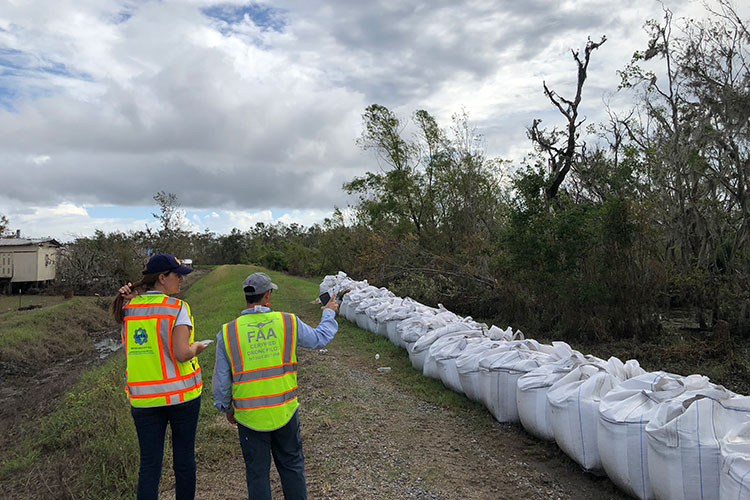When extreme events are no longer rare: Lessons from Hurricane Ida
After documenting the destruction in Louisiana, a Berkeley engineer shares thoughts on designing resilient infrastructure for a warming world
September 21, 2021

UC Berkeley professor Adda Athanasopoulos-Zekkos is part of a small team of engineers that visited southeast Louisiana last week to document the damage wrought on levees, power systems and other infrastructure by Hurricane Ida. (Photo by Hai Lin)
When Hurricane Ida barreled into Louisiana late last month, bringing 10- to 15-foot storm surges and record-breaking winds, many wondered whether the New Orleans’ levee system — newly rebuilt at a cost of approximately $14.5 billion — would be strong enough to prevent the catastrophic flooding that inundated the city following Hurricane Katrina in 2005.
The levees appear to have held — but three weeks later, many Louisiana residents remain without power.
To learn more about the impact of Hurricane Ida — and how it compares to the impact of Hurricane Katrina 16 years ago — Berkeley News spoke with civil and environmental engineering professor Adda Athanasopoulos-Zekkos, who traveled to Louisiana last week as part of a team of engineers organized by the National Science Foundation’s Geotechnical Extreme Events Reconnaissance (GEER) Association.
The team spent three days crisscrossing the southeastern corner of Louisiana, collecting photographs, videos and other documentation of the hurricane’s impact on the state’s levee and power systems. They will return later in the month for a more thorough assessment.
Athanasopoulos-Zekkos, who also visited Louisiana after Hurricane Katrina as part of an earlier GEER team, shared her observations from the recent visit and what she thinks these disasters can teach us about climate resilience.

Adda Athanasopoulos-Zekkos is a professor of civil and environmental engineering at UC Berkeley.
What are some of your initial impressions of the impacts of Hurricane Ida on Louisiana?
One of the most important observations is that the levee system that protects the city of New Orleans — and that failed at several locations following Hurricane Katrina — performed as expected in this event. This was a very strong hurricane that loaded the system with storm surge and winds, and it performed very, very well. We did see a lot of flooding and some partial levee failures in Grand Isle, which was where Ida made landfall. But these are not federally owned and operated levees and are not necessarily built to the same standards.
However, energy and the lack of electricity is probably going to be the main story of Hurricane Ida. This is something that we saw everywhere, just poles knocked over, cut wires lying on the ground. And there are so many people working to bring that system back up. Everywhere we drove, there were trucks with workers from Entergy, the local electric company, and others, as well, trying to get that infrastructure back up. We should also keep in mind that it is very hot and humid in Louisiana right now. Lack of electricity means lack of access to air conditioning, for example, and if you’re trying to pump water, it means you need to have a backup generator to do so.
It does seem that much of news coverage of Hurricane Ida has focused on the impacts of the massive power outage, and people suffering without things like air conditioning. Did your team observe any other impacts that haven’t received as much coverage, or that you think might surprise people?
Many people are still being asked to be very careful with clean water usage, for example, and to not overstress that system, so that everybody can have some access to clean water.
Another important issue is the question of what happens with all the hurricane debris. It’s unbelievable to drive through neighborhoods and just see these piles — almost mountains — of debris. And this consists of everything from cut-up tree branches and organic debris to household debris, because basically everything that was in a flooded house can no longer be used. We saw everything out on the street in piles, from refrigerators to furniture to clothes to kids’ toys, and even electrical devices and appliances.
One of my colleagues, associate professor Navid Jafari from Louisiana State University, who is my co-lead on the project, told me that some of these events produce the same amount of waste that this area normally would have created in a year. In the past, if you had one of these events every 50 years, one can argue that a country like the U.S. would be able to accommodate that. But now, with everything that’s happening — with wildfires in the West, flooding in the East and hurricanes in the South — I think we need to really start addressing the issue of where is all this debris going to end up.
I imagine that some of this waste could also be hazardous or toxic, as well.
Oh, absolutely. Many of these areas were under 10, 11, 12 feet of water. And they included gas stations, cemeteries and many other things that are now seeping into this groundwater table.

While New Orleans’ new $14.5 billion levee system protected the city from major flooding during Hurricane Ida, the team visited areas near Grand Isle, LA, where local levees failed. (Photo courtesy of Adda Athanasopoulos-Zekkos)
What do you think we have learned about managing these climate disasters in the 16 years between Hurricane Katrina and Ida? What other protections do we need to put in place?
With Hurricane Katrina, the main highlight was all the levee failures, and all of the things that the Army Corps of Engineers changed following that event. And that includes both physical infrastructure, but also organizational infrastructure within the agency itself. For example, making sure there are many layers of oversight for different tasks, and having a more clearly laid out organizational structure in terms of who is responsible for what. I think that also significantly improved and is working better right now.
However, we still need to look more closely at many of the effects. We’re still trying to collect data, for example, on the three major pipelines that bring crude oil through Port Fourchon. We have some unconfirmed reports that parts of that pipeline system may have been affected. And when these pipelines get shut down, which was the case with one of the three, that can be felt as gas shortages or prices spiking in other areas. So, all of a sudden, you’re paying more for gas in Michigan because of an event that happened in Louisiana.
And this just shows how connected all these systems are, and how we learn to depend on parts of the infrastructure that may not even be physically close to us. It’s really important to understand these interdependencies and try to have backup plans and redundancies and various layers of protection. I think this is going to be what a lot of people are going to look into, especially with the failure of the delivery of electricity into the city.
It seems like we as a society have a pattern of waiting until infrastructure fails before addressing its vulnerabilities. As climate change increases the likelihood of extreme weather events, what do you think it will take for us to start to really plan ahead for these risks?
I think you bring up an excellent point, and this is why it is so important to have diverse, multidisciplinary teams working together. For us to make progress on addressing these disasters in a good, smooth way, without aggravating communities and forcibly changing their way of life, we need to have everybody sitting around the table, including engineers, stakeholders, community representatives, scientists and policy people, so that we can finally say, “OK, this is what we’ve been dealing with over the last 10 or 20 years. How can we bring everything together and make sure that we are truly more resilient as a society and not have to wait every time for the next event to learn a new lesson?”
And that will continue to happen to a certain degree, but there is a lot of information now available that should allow us to hold ourselves to a very high standard and say, “Should we have known better?”

Athanasopoulos-Zekkos and Louisiana State University professor Navid Jafari visit a flooded site near the town of Lafitte, LA. (Photo by Hai Lin)
Do you have any examples of what more resilient systems would look like?
Well, for example, in the case of Hurricane Ida, it would have meant that there was some backup system to deliver electricity. When transmission towers or central points of delivery of electricity are taken down, it’s not just an inconvenience for certain neighborhoods. It becomes dangerous, because it can affect many other components of the system, such as health care delivery or the ability to operate water pumps. The Army Corps of Engineers, for example, has backup generators for the water pumps that operate in the three main canals that go into the heart of New Orleans. And so, we need to think, “OK, we have that backup plan for the pumps, what’s the second layer that we need to protect? How are we making sure that we can continue to bring electricity to our hospitals? How can we continue to bring electricity across the transportation network so that the traffic lights keep working, so people can still go where they need to go in a safe way?”
How can people start to think more critically about the risks we face from climate change, both individually and as a society?
I think this is going to be a very important conversation over the next several years. For me, I think it definitely needs to start from early childhood education. And by that I mean that we need to make sure that everybody who is a citizen of this country, and of the world, needs to really understand how infrastructure works — where the resources are coming from, where the dangers are coming from, how the dangers are increasing in frequency, and what that means for certain areas.
The Dutch offer a great example of how to do this. In the Netherlands, people are living on land that is below sea level, and so canals, pumping and flood protection are all part of their way of life. Starting in kindergarten, kids are taught how the water system, drainage and sewers are built, and how the various parts of infrastructure contribute to their safety. So, as they’re growing up, it’s really ingrained into them that flooding is a major threat for their country.
Unfortunately, given climate change, it needs to be ingrained into all of us that there’s going to be flooding, there are going to be wildfires, there’s going to be a lot of these extreme events that are no longer rare. And so, we need to make it a bigger part of our education. And hopefully, by the time the next generation of engineers gets here, it will be much easier to convince people of why risk reduction is so important, and they can move faster toward real solutions.